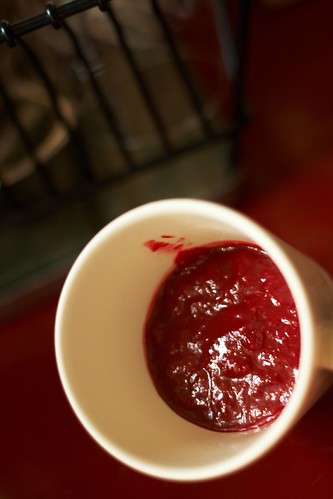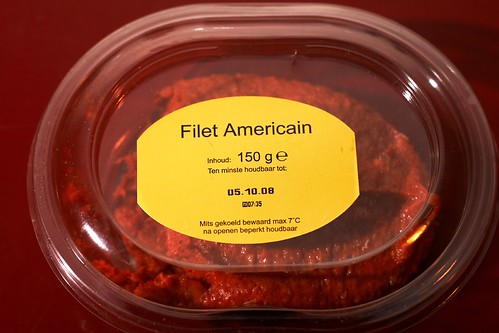Having a place of my own and a kitchen to myself means I can procrastinate all I want. Most recently I had some nice strawberries that I had bought for smallgroup, but had forgotten to bring out after dinner. A week later, they weren't in the best shape; I thought I'd cut them up and toss them in a pan and make some glazed strawberries to put atop my ice cream (yeah, my average saturday night when I'm down with a cold - I needed the vitamin C). I ended up with more strawberries than ice cream, so the rest ended up in an impromptu strawberry jam, which I was pretty happy with. Ended up in a home-made pop-tart the next morning in conjunction with some mini-pita bread and penotti duo (nutella-like spread).

The next item is a mystery inside an enigma, put through a meat grinder and masked in artificial food colouring. The concoction is known "Filet Americain", which begs the questions, where does the concept of "filet" come in, and what's so "Americain" about it (bonus question: where does "Americain" come from, since the Dutch word is "Amerikaan")? Wikipedia claims it's simply the Belgian term for steak tartare, but as you can see from the image below, the produce is actually rather different.

A steak tartare is identifiable as finely chopped raw beef, mixed with spices, olive oil, and perhaps a raw egg. Along with carpaccio, I have the mental image that it's a European dish. I've met one too many Americans who find any sort of raw food too exciting to think that such a dish could originate in the US (although I rather do enjoy raw beef, provided it's served at a reputable enough establishment).
A "filet Americain" though, is sold at supermarkets, with an expiry date at least two weeks out of the purchase date. The meat is ground to the consistency of a paste, and both the texture and flavour are closer to pate than beef. My understanding of economics and food preparation says that meat ground to the point of being unidentifiable is most likely from an inexpensive cut rather than a filet. The fact that it has a two week shelf life suggests that it makes heavy uses of nitrates/nitrite and food colouring to ensure that it remains a tasty orange instead of a drab grey. All in all though, it's a fairly tasty meat-that-you-can-spread-on-toast.
No comments:
Post a Comment